Module 18: Creative outreach
#Faith4Rights toolkit
Full text of commitment XVIII
| We pledge to use technological means more creatively and consistently in order to disseminate this declaration and subsequent Faith for Rights messages to enhance cohesive societies enriched by diversity, including in the area of religions and beliefs. We will also consider means to produce empowering capacity-building and outreach tools and make them available in different languages for use at the local level. |
Context
A knowledge management momentum is at the heart of commitment XVIII. It ensures the sustainability of interfaith learning and collaboration. In an era of information technology, faith education and inter-faith engagement should not be confined to outdated techniques. Violent extremist groups understood the potential of this area and filled the void before the mainstream religious institutions. It is reassuring, however, to see that many faith-based organizations have started to dedicate increased attention to the role of technology in achieving faith goals and engagement within and across communities. This #Faith4Rights toolkit provides numerous examples of where to search in order to facilitate the task of religious educators and faith actors benefiting from human rights standards and methodologies. Innovative learning and communication approaches need to be further developed.
The “three Ms” (MOOC, Moot, Masters) constitute promising avenues in this respect. Smartphone applications and websites provide a cost-effective low-hanging fruit in terms of outreach and appeal to the younger generation. Faith actors should be able to log into user-friendly, dedicated databases to find the information they need regarding the impact of their work on human rights and the corresponding Sustainable Development Goals. Relevant information and developments should be readily available for faith actors through these mutually reinforcing tools to enhance their social impact. Interfaith dialogues are useful but their benefit could be lost once an activity is over. Enhancing the impact of inter-faith engagement in a sustainable manner is both needed and possible.
Additional supporting documents
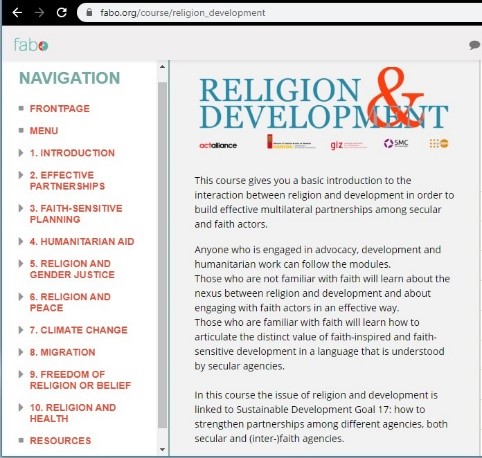 ACT Alliance (co-sponsored by the Swedish Mission Council, Gesellschaft für Internationale Zusammenarbeit and Danida) offers the online course “Religion & Development”, which gives a basic introduction to the interaction between religion and development in order to build effective multilateral partnerships among secular and faith actors. It contains sections on effective partnerships, faith-sensitive planning, humanitarian aid, gender justice, peace, climate change, migration, health and freedom of religion or belief. Its section on resources also refers to the Beirut Declaration and its 18 commitments on “Faith for Rights”.
ACT Alliance (co-sponsored by the Swedish Mission Council, Gesellschaft für Internationale Zusammenarbeit and Danida) offers the online course “Religion & Development”, which gives a basic introduction to the interaction between religion and development in order to build effective multilateral partnerships among secular and faith actors. It contains sections on effective partnerships, faith-sensitive planning, humanitarian aid, gender justice, peace, climate change, migration, health and freedom of religion or belief. Its section on resources also refers to the Beirut Declaration and its 18 commitments on “Faith for Rights”.
The Freedom of Religion or Belief Learning Platform provides resources to help individuals, communities and decision-makers learn, reflect upon and promote freedom of religion or belief for all. The platform includes films and written resources for personal study and for group trainings, tailored to educators, facilitators, legislators, officials, diplomats and the media as well as for theological and ethical reflection.
In June 2021, the United States Institute of Peace launched an online course on “Religious Engagement in Peacebuilding - A Common Ground Approach”. It is designed as a resource for those working in peacebuilding who may be unfamiliar with (or even wary of) religious engagement, or who are looking to gain greater confidence in working with religious actors and institutions. The online course also refers to the Beirut Declaration, #Faith4Rights toolkit and Rabat Plan of Action. See also the online conversation on a “Faith for Rights” Approach to Promoting Sustainable Peace (December 2021).
Peer-to-peer learning exercises
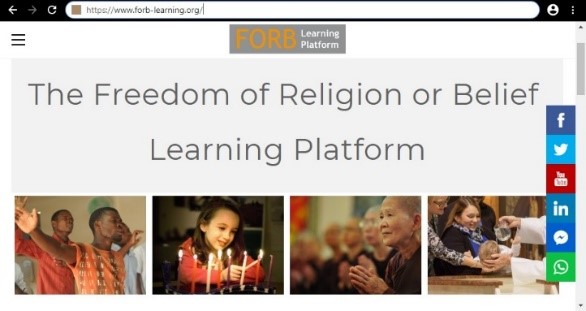 Unpacking: Participants break down commitment XVIII into different elements (individual exercise for five minutes followed by ten minutes of a full group discussion on the differences between individual listings).
Unpacking: Participants break down commitment XVIII into different elements (individual exercise for five minutes followed by ten minutes of a full group discussion on the differences between individual listings).
Linking the dots: Participants discuss the relationship between these elements and link them notably to commitments XII and XVII (collective exercise for ten minutes).
Critical thinking: The facilitator could ask the participants if they disagree with any of these elements? Can any of them stand alone? Are there missing elements in that commitment? (Collective exercise for 20 minutes)
Tweeting: Participants summarize commitment XVIII within 140 characters (Individual exercise for five minutes). One possible result of this tweeting exercise could be as follows: “We commit to use technological means more creatively and consistently in order to produce capacity-building and outreach tools and make them available for use at the local level”.
Translating: Similar to the tweeting exercise, participants could be asked to “translate” this commitment into child-friendly language or into a local dialect. Again the idea is to stimulate discussion about the most important elements and appropriate ways of transposing and simplifying the message, without losing the substance of the commitment.
Storytelling: Participants discuss relevant situations that occurred to them personally pertaining to this commitment and how they handled them. In particular, how can technological means be used to disseminate “Faith for Rights” messages to enhance cohesive societies enriched by diversity, including in the area of religions and beliefs? (Collective exercise for 15 minutes)
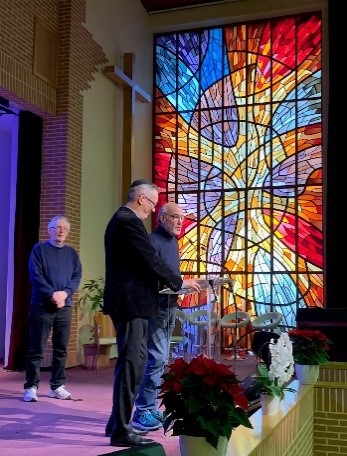 Exploring: Develop projects for capacity-building and outreach tools in different languages for use at the local level (discussion in working groups for 30 minutes, followed by presentation of the project proposals in plenary). Two examples of joint outreach activities are publishing an interreligious calendar and organizing an annual Walk of Faith for Rights,
Exploring: Develop projects for capacity-building and outreach tools in different languages for use at the local level (discussion in working groups for 30 minutes, followed by presentation of the project proposals in plenary). Two examples of joint outreach activities are publishing an interreligious calendar and organizing an annual Walk of Faith for Rights,
as envisaged in the Beirut Declaration: “We aim to achieve that goal in a concrete manner that matters for people at the grassroots level in all parts of the world where coalitions of religious actors choose to adhere to this declaration and act accordingly. We will support each other’s actions, including through a highly symbolic annual Walk of Faith for Rights in the richest expression of our unity in diversity each 10th of December in all parts of the world.”
Simulating: This exercise is a competition, conducted and arbitrated by the participants themselves. It aims at crowning the whole “Faith for Rights” learning trajectory through the simulation of “Advice to the president”. It consists of either a group or individual exercise whereby participants play the role of an adviser to the president for religious affairs. Each “adviser to the president” will be asked to draft a single-page proposal as an advice to the president with respect to commitment XVIII as it relates to outreach and awareness raising of the whole “Faith for Rights” framework. However, participants should be free to add one or more areas within the scope of the 18 modules. The reason for this is that participants should be completely free, in this final exercise, to express their own understanding of the interdependence between the 18 commitments. The proposal can relate to a legislative change, a policy direction or an institutional innovation.
The guidelines for this exercise are conciseness, clarity, action-orientation, substantiation of the proposal by standards and material provided by the #Faith4Rights toolkit, practical feasibility, and description of action points needed to implement the proposal and how to measure its impact. These seven guidelines are at the same time the criteria for evaluation by each participant of the proposals written by other participants. At the end of the exercise, the three proposals with the highest scores will receive symbolic awards.

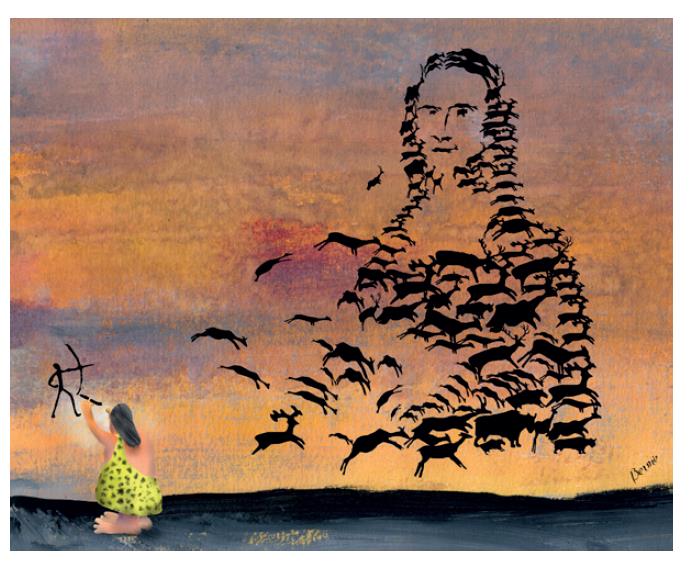 Adding faith quotes: Participants search religious or belief quotes to commitment XVIII (individual exercise for five minutes, followed by a reading from each participant of his or her added reference).
Adding faith quotes: Participants search religious or belief quotes to commitment XVIII (individual exercise for five minutes, followed by a reading from each participant of his or her added reference).
Inspiring: Participants share artistic expressions they know of that capture aspects of the commitment under discussion. In addition, please find here the example of a cartoon, calligraphy and virtual music making during the coronavirus crisis (remote recording of the composition “Seasons in the Time of Corona”).
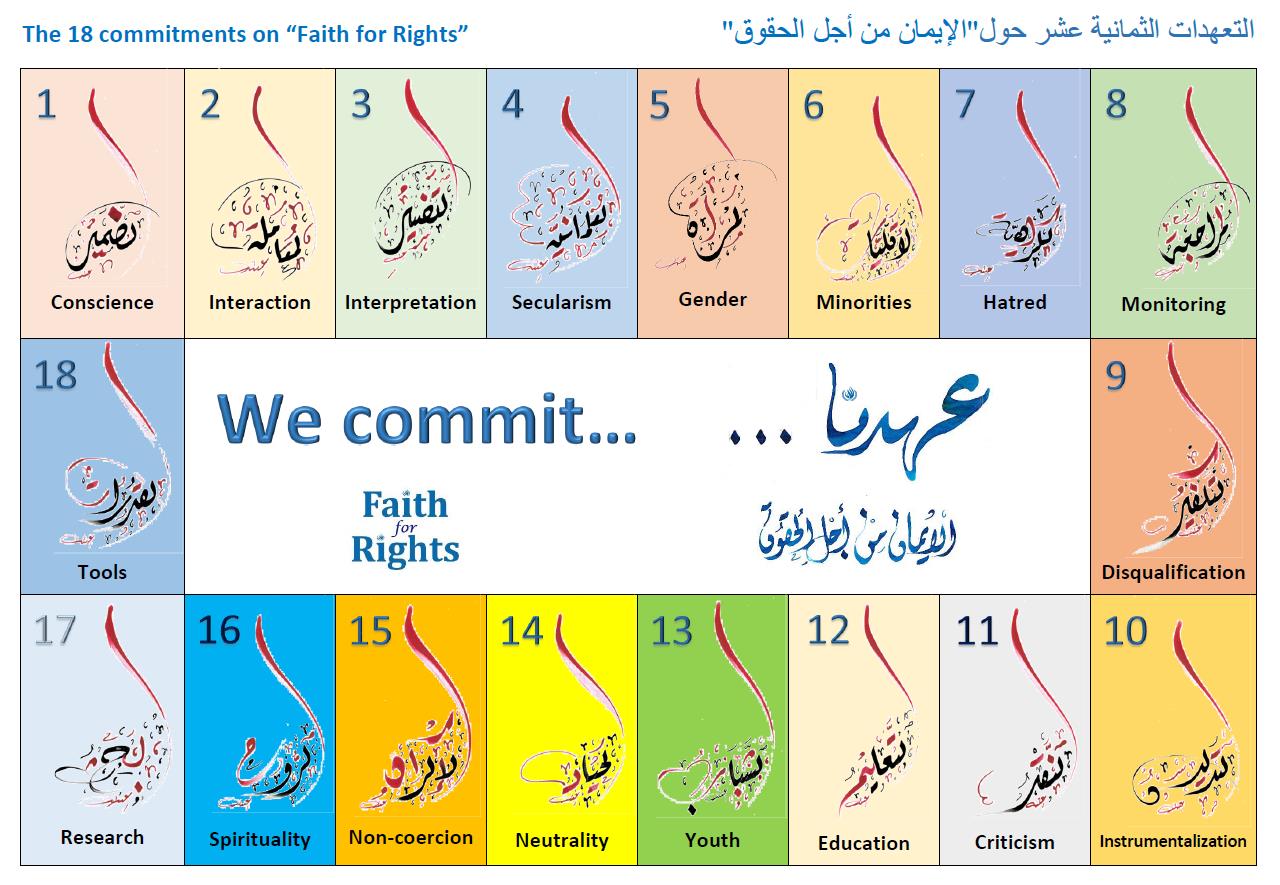
Inventing: The facilitator could also encourage the participants to think outside the box, for example by inventing a boardgame based on the 18 commitments on “Faith for Rights”, such as by using the calligraphic illustrations as the board and drafting questions, action points and rules for the players. In terms of creativity, not even the sky is the limit.
Learning objectives
- Participants become aware of the need, like in all professions, for updating their skills in areas impacting on their functions. This includes inter-cultural competencies, religious literacy, human rights literacy, planning activities, conflict resolution, mediation and new communication technologies.
- Participants are more familiar with research tools and key resources of training and education on freedom of the religion or belief in its fullest human rights spectrum.
- Communities of practice are born naturally over time and interested participants pursue their peer-to-peer learning in a sustainable, low-cost and environmentally-friendly manner.
- Faith engagement becomes an interactive, creative and technologically supported process of learning through diversity.
previous module ¦ overview >